The Wolf and the Seven Young Goats
Reading time: 7 min
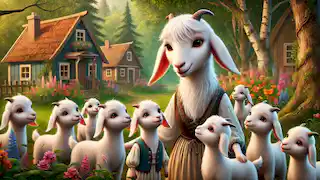
About this story: The Wolf and the Seven Young Goats is a Fairy Tale from Germany set in the Medieval This Simple tale explores themes of Good vs. Evil and is suitable for Children. It offers Moral insights. A tale of cleverness, vigilance, and maternal bravery.
In a quaint village at the edge of an enchanted forest, there lived a mother goat with her seven young kids. The kids were full of energy and curiosity, always eager to explore their surroundings. The mother goat, however, was wise and knew of the dangers lurking in the forest, especially the cunning and malevolent wolf who prowled nearby.
One sunny morning, as the birds sang and the flowers bloomed, Mother Goat gathered her kids around her. "Dear children," she began, her voice filled with concern, "I must go to the market to fetch food for us. While I am away, you must be very careful and stay inside the house. Remember, the wolf is always on the lookout for a chance to catch you. Be vigilant and do not open the door for anyone unless you are absolutely sure it is me."
"But Mother," the eldest kid spoke up, "how will we know it's really you?"
Mother Goat smiled reassuringly. "I will knock on the door and say, 'It is I, your mother, back with food for all.' But remember, the wolf might try to deceive you, so listen closely to my voice and look at my feet, for they are white like snow. The wolf's paws are dark and filthy."
With that, Mother Goat hugged each of her kids and set off toward the market, leaving the young goats behind. They watched her until she disappeared down the path, her bell tinkling softly in the distance.
Time passed slowly, and the kids busied themselves with games and stories. They played tag and hide-and-seek, their laughter filling the air. As they played, the eldest kid kept a watchful eye on the door, remembering their mother's warning.
Suddenly, there was a knock at the door, and a gruff voice called out, "Open the door, dear children, it is I, your mother, back with food for all."
The kids froze. The eldest, remembering their mother's warning, approached the door cautiously. "Show us your feet," he demanded.
The wolf, who had covered his paws in flour to appear like Mother Goat's white feet, lifted them up to the window. Seeing the white feet, the eldest kid was convinced and opened the door.
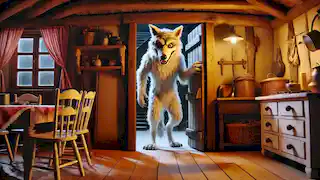
To their horror, in rushed the wolf, his eyes gleaming with malice. The kids scattered in all directions, trying to find places to hide. One dove under the bed, another hid in the cupboard, and the smallest one scrambled into the grandfather clock. The wolf, however, was relentless. He sniffed them out one by one, swallowing each whole until only the smallest kid remained, hidden in the clock.
Satisfied with his meal, the wolf left the house, his belly grotesquely swollen, and went to a meadow nearby to rest under a tree. He lay down and soon fell into a deep sleep, snoring loudly.
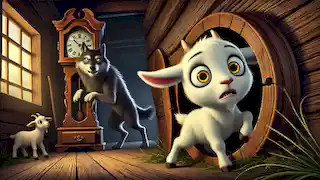
When Mother Goat returned from the market, she was horrified to find the door wide open and the house in disarray. Her heart pounded in her chest as she called out for her children. "My dear children, where are you?"
There was no answer. With a sinking heart, she searched the house. She found the furniture overturned, the cupboards empty, and the bed sheets rumpled. Finally, she heard a faint, trembling voice coming from the grandfather clock. She opened the clock and out tumbled the youngest kid, tears streaming down his face.
"Oh, Mother," he cried, "the wolf came and ate all my brothers and sisters!"
Mother Goat's heart broke at the sight of her only remaining child. She wept for her lost children, but soon gathered her wits. She knew she had to find the wolf and save her kids if there was any hope left. Guided by the youngest kid, who had seen which way the wolf went, they set off toward the meadow.
There, under a tree, lay the wolf, snoring loudly, his belly grotesquely swollen. Mother Goat approached cautiously and saw movements inside the wolf's belly. Her kids were still alive! She quickly fetched a pair of scissors, a needle, and some thread from a nearby cottage.
With great care, she cut open the wolf's belly, and one by one, her children tumbled out, shaken but unharmed. They hugged their mother tightly, grateful and relieved to be alive. Then, Mother Goat filled the wolf's belly with heavy stones and stitched him back up.
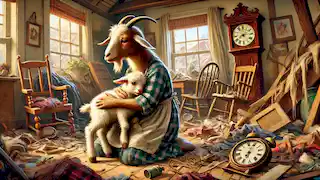
The wolf awoke with a groan, feeling an unbearable thirst from the weight in his stomach. He stumbled to a nearby well to drink. But as he leaned over the edge, the weight of the stones pulled him in, and he drowned in the deep, cold water.
Mother Goat and her seven kids returned home, grateful to be safe and together again. The children learned a valuable lesson that day about the importance of vigilance and heeding their mother's warnings. From then on, they were always careful and stayed close to their mother, never forgetting the danger of the cunning wolf.
The village celebrated the return of the young goats, and the story of their narrow escape spread far and wide, a reminder to all of the importance of family, wisdom, and caution in the face of danger.
And so, Mother Goat and her seven kids lived happily ever after, always vigilant but grateful for each day they had together, forever bonded by their harrowing adventure and the love that had kept them safe.
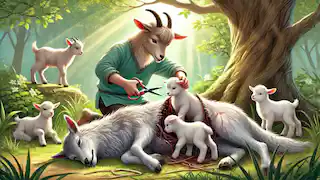
The tale of the wolf and the seven young goats continued to be told to each new generation in the village. The kids, now more aware of the dangers outside, grew up to be wise and cautious adults, teaching their own children the same lessons of vigilance and trust.
In the evenings, as the sun set and the shadows lengthened, the goats would gather around the fire and tell stories of their bravery and the cleverness of their mother. They spoke of the wicked wolf and how they outsmarted him, filling the young ones with awe and a sense of adventure.
The forest, once a place of fear, became a symbol of their triumph. The goats ventured into it only when necessary, always in groups and always on guard, respecting the wisdom of their mother's teachings.
The eldest kid, who had first opened the door to the wolf, took the lesson to heart the most. He grew to be a strong and protective leader, ensuring the safety of his family and community. He never forgot the mistake he made but used it as a guiding principle to be ever more vigilant and discerning.
The youngest kid, who had hidden in the clock, became known for his quick thinking and bravery. He shared his tale with pride, knowing that his small size had not hindered his ability to contribute to the family's safety.
Mother Goat, revered and respected, became a symbol of wisdom and maternal strength in the village. Her actions had saved her children, and her story inspired others to be brave and resourceful in the face of danger.
Years passed, and the village thrived, growing larger and more prosperous. The story of the wolf and the seven young goats became a cornerstone of their culture, a tale told to every child, instilling in them the values of caution, wisdom, and the importance of family.
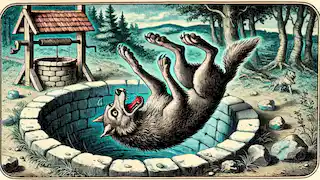
The enchanted forest, with its dark secrets and lurking dangers, remained a constant reminder of the world beyond the safety of their homes. The goats learned to navigate it with respect and caution, never forgetting the lessons of their past.
And so, the legacy of the wolf and the seven young goats endured, a timeless story of survival, cleverness, and the unbreakable bonds of family. The village continued to tell the tale, each retelling reinforcing the values that had kept them safe and strong through the years.










